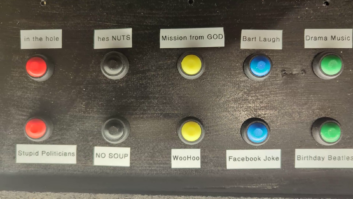The sound of effects and equalization can be hard to translate into engineering terms.
For example, what sort of EQ should you use to get a “fat” sound or a “thin” sound? Does your station sound “meaty” or “squashed?”
This glossary may help. It is based on conversations with producers, musicians and reviewers over many years. While not everyone agrees on these definitions, they are common.
Airy: Spacious. The instruments sound like they are surrounded by a large reflective space full of air. Some leakage between microphones. A pleasant amount of reverb. High-frequency response that extends to 15 or 20 kHz.
Ballsy or Bassy: Emphasized low frequencies below about 200 Hz.
Bloated: Excessive mid-bass around 250 Hz. Poorly damped low frequencies, low-frequency resonances.
Bloom: Adequate low frequencies. Spacious. Good reproduction of dynamics and reverberation. Early reflections or a sense of “air” around each instrument in an orchestra.
Boomy: Excessive bass around 125 Hz. Poorly damped low frequencies or low-frequency resonances.
Boxy: Having resonances as if the music were enclosed in a box. Speaker cabinet diffraction or vibration. Sometimes an emphasis around 250 Hz to 500 Hz.
Breathy: Audible breath sounds in vocals, flute or sax. Good or emphasized high-frequency response.
Bright: Strong in the treble. High-frequency emphasis. Harmonics are strong relative to fundamentals.
Brittle: High-frequency peaks, or weak fundamentals. Slightly distorted or harsh highs. Opposite of round or mellow. (See Thin.) Objects that are physically thin and brittle emphasize highs over lows when you crack them. Bad A/D converters with low bit depth can sound brittle.
Chesty: The vocalist sounds like his or her chest is too big. A bump in the low-frequency response around 125 to 250 Hz.
Clean: Free of noise, distortion and leakage.
Clear: See Transparent.
Clinical: Too clean or analytical. Emphasized high-frequency response, sharp transient response. Not warm.
Colored: Having timbres that are not true to life. Non-flat response, peaks or dips.
Constricted: Poor reproduction of dynamics. Dynamic compression. Distortion at high levels. (Also see Pinched.)
Crisp: Extended high-frequency response. Like a crispy potato chip, or crisp bacon frying. Often referring to cymbals.
Crunch: Pleasant guitar-amp distortion.
Dark; Dull: Opposite of bright. Weak high frequencies.
Delicate: High frequencies extend to 15 or 20 kHz without peaks. A sweet, airy, open sound with strings or acoustic guitar.
Depth: A sense of closeness or distance of instruments, caused by miking them at different distances. Good transient response that reveals the direct/reflected sound ratio in the recording.
Detailed: Easy to hear tiny details in the music; articulate. Adequate high-frequency response, sharp transient response.
Dry: Without effects. Not spacious. Reverb tends toward mono instead of spreading out. Overdamped transient response.
Edgy: Too much high frequency. Trebley. Harmonics are too strong relative to the fundamentals. When you view the waveform on an oscilloscope, it even looks edgy or jagged, due to excessive high frequencies. Distorted, having unwanted harmonics that add an edge or raspiness to the sound.
Effortless: Low distortion, usually coupled with flat response.
Etched: Clear but verging on edgy. Emphasis around 10 kHz or higher.
Fat: See Full and Warm. Also, a diffuse spatial effect. Also, smeared out in time, with some reverberant decay.
Focused: Referring to the image of a musical instrument, which is easy to localize, pinpointed, having a small spatial spread.
Forward: Sounding close to the listener, projected. Emphasis around 2 to 5 kHz. Also, loud in the mix.
Full: Opposite of Thin. Strong fundamentals relative to harmonics. Good low-frequency response, not necessary extended, but with adequate level around 100 to 300 Hz.
Gentle: Opposite of edgy. The harmonics – highs and upper mids – are not exaggerated, or may even be weak.
Glare, Glassy: A little less extreme than edgy. A little too bright or trebley.
Grainy: The music sounds like it is segmented into little grains, rather than flowing in one continuous piece. Not liquid or fluid. Suffering from harmonic or I.M. distortion. Some early A/D converters sounded grainy, as do current ones of inferior design. Powdery is finer than Grainy.
Grungy: Lots of harmonic or I.M. distortion.
Hard: Too much upper midrange, usually around 3 kHz. Also as with good transient response, as if the sound is hitting you hard.
Harsh: Too much upper midrange. Peaks in the frequency response from 2 to 6 kHz. Or, excessive phase shift.
Heavy: Good low-frequency response below about 50 Hz. Suggesting an object of great weight or power, like a diesel locomotive or thunder.
Hollow: Too much reverberation or when there is a mid-frequency dip. (Also see Honky.)
Honky: The music sounds the way your voice sounds when you cup your hands around your mouth. A bump in the response around 500 to 700 Hz.
Liquid: Opposite of Grainy. A sense of seamless flowing of the music. Flat response and low distortion. High frequencies are flat or reduced relative to mids and lows.
Low-fi (low fidelity): “Trashy” sounding. Tinny, distorted, noisy or muddy.
Meaty: A combination of Crunch and Warmth. Pleasant amount of low frequencies, perhaps with some euphonic distortion or compression.
Mellow: Reduced high frequencies, not edgy.
Muddy: Not clear. Weak harmonics, smeared time response, IM distortion. Too much reverb or leakage at low frequencies.
Muffled: The music sounds covered up. Weak highs or weak upper mids.
Musical: Conveying emotion. Flat response, low distortion, no edginess.
Nasal: The vocalist sounds like he or she is singing with the nose closed. Also applies to strings. Bump in the response around 300 to 1,000 Hz. (See Honky).
Neutral: Accurate tonal reproduction. No obvious colorations. No serious peaks or dips in the frequency response.
Papery: Referring to a kick drum that has too much output around 400 to 600 Hz.
Pinched: Narrowband. Midrange or upper-midrange peak in the frequency response. Pinched dynamics are overly compressed.
Piercing: Strident, hard on the ears, screechy. Having sharp, narrow peaks in the response around 3 kHz to 10 kHz.
Present, presence: Adequate or emphasized response around 5 kHz for most instruments, or around 2 to 5 kHz for kick drum and bass. Having some edge, punch, detail, closeness and clarity.
Puffy: Bump in the response around 500 to 700 Hz.
Punchy: Good reproduction of dynamics. (But note, some people call the sound of compression “punchy.” Go figure.) Good transient response. Sometimes a bump around 200 Hz.
Raspy: Harsh, like a rasp. Peaks in the response around 6 kHz, which make vocals sound too sibilant or piercing.
Rich: (See Full.) Also, having euphonic distortion made of even-order harmonics.
Round: High-frequency rolloff or dip. Not edgy.
Sharp: See Strident and Tight.
Sibilant, Essy: Exaggerated “s” and “sh” sounds in singing, caused by a rise in the response around 5 to 10 kHz.
Sizzly: (See Sibilant.) Also, too much highs on cymbals.
Smeared: Lacking detail. Poor transient response. This may be a desirable effect in large-diameter microphones. Also, poorly focused images.
Smooth: Easy on the ears, not harsh. Flat frequency response, especially in the midrange. Lack of peaks and dips in the response.
Spacious: Conveying a sense of space, ambience, or room around the instruments. To get this effect, mic farther back, mix in an ambience microphone, add reverb or record in stereo. Components that have out-of-phase crosstalk between channels may add false spaciousness.
Squashed: Overly compressed.
Steely: Emphasized upper mids around 3 – 6 kHz. Peaky, nonflat high-frequency response. (See Glassy, Harsh, Edgy.)
Strained: The component sounds like it’s working too hard. Distorted. Inadequate headroom or insufficient power. Opposite of effortless.
Strident: See Harsh and Edgy.
Sweet: Not strident or piercing. Flat high-frequency response, low distortion. Lack of peaks in the response. Highs extend to 15 or 20 kHz, but they are not bumped up. Often used when referring to cymbals, percussion, strings, and sibilant sounds.
Thin: Fundamentals are weak relative to harmonics. Note that the fundamental frequencies of many instruments are not very low. For example, violin fundamentals are around 200 to 1,000 Hz. So if the 300 Hz area is weak, the violin may sound thin – even if the violin mic’s response goes down to 40 Hz.
Tight: Good low-frequency transient response. Absence of ringing or resonance when reproducing the kick drum or bass. Good low-frequency detail. Absence of leakage. Also refers to highly synchronized playing of musicians.
Tinny, Telephone-Like: Narrowband, weak lows, peaky mids. The music sounds like it’s coming through a telephone or tin can.
Transparent: Easy to hear into the music, detailed, clear, not muddy. Wide flat frequency response, sharp time response, very low distortion and noise.
Tubby: See Bloated. Having low-frequency resonances as if you’re singing in a bathtub.
Veiled: The music sounds like you put a silk veil over the speakers. Slight noise or distortion, or slightly weak high frequencies.
Warm: Good bass, adequate low frequencies, adequate fundamentals relative to harmonics. Not thin. Or, excessive bass or midbass. Or, pleasantly spacious, with adequate reverberation at low frequencies. Or, gentle highs, like from a tube amplifier. See Rich.
Wooly or Blanketed: The music sounds like there’s a wool blanket over the speakers. Weak high frequencies or boomy low frequencies. Sometimes, an emphasis around 250 to 600 Hz.
Tell us about your special words to describe the sounds of audio and radio. Write to [email protected]












